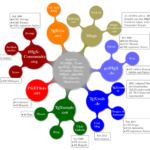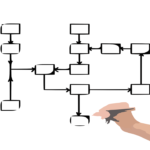This site was developed originally to provide resources for the 2019 W&M Teaching and Learning Symposium session entitled, Shifting the Faculty Role in Learning: Decisions and Tools for Student Collaboration. Please click here to view our slides from the session. Collaboration offers many benefits for students, but also comes with it’s share of concerns […]
Case Study
Description: In a Case Study student teams “review a written study of a real-life scenario containing a field-related problem situation. These cases usually include a brief history of how the situation develop and present a dilemma that a key character within the scenario is facing (Barkley, et al, 2014, p. 238). Students then draw on […]
Word Webs
Description: Word Webs are a collaborative approach to concept mapping. A central idea is added to a shared writing space. In small groups, students then generate a list of related ideas and organize them around the central idea in which they can visually represent how the ideas connect. This technique helps students to analyze challenging […]
Sequence Chains
Description: In this activity groups of students “analyze and depict graphically a sequence of events, actions, roles, or decisions. Sequence chains require students to create a visual map of the logic within a series” (Barkley, et al, 2014, p. 278). Students have to work together to identify the key events or points in the series […]
Dialogue Journals
Description: In this activity, students keep a journal to capture their thinking about course readings, assignments, lectures, and class activities. They then exchange their journal with a peer to create an ongoing dialogue of questions, answers, insights and ideas. The students can develop their journal in a digital or analog format. The instructor can prompt […]
Test-Taking Teams
Description: In this activity, students work in teams to prepare for a class exam. They then take the exam individually. Then, before the exam is graded, students meet back in their teams to discuss their answers, and particularly any discrepancies. The team can either turn in one exam for the group or each student can […]
Note-Taking Pairs
Description: In this activity student partners work together to improve their note-taking skills. Over time, each student improves her individual note-taking skills. By working in pairs, students can compare notes on a class lecture, reading or other activity. They help each other to fill in the gaps in their notes, correct inaccuracies, and add detail […]
Learning Teams
Description: For this type of group, students are divided into groups at the beginning of the term. When you want to incorporate small group discussion or teamwork into your class, you direct the students to get into these term-long learning groups. Groups of four work well, because each foursome can be subdivided into pairs, depending […]
Fishbowl
Description: This method involves one group observing another group. The first group forms a circle and either discusses an issue or topic, does a role play, or performs a brief drama. The second group forms a circle around the inner group. Depending on the inner group’s task and the context of your course, the outer […]
Jigsaw
Description: This strategy involves students becoming “experts” on one aspect of a topic, then sharing their expertise with others. Divide a topic into a few constitutive parts (“puzzle pieces”). Form subgroups of 3-5 and assign each subgroup a different “piece” of the topic (or, if the class is large, assign two or more subgroups to […]








